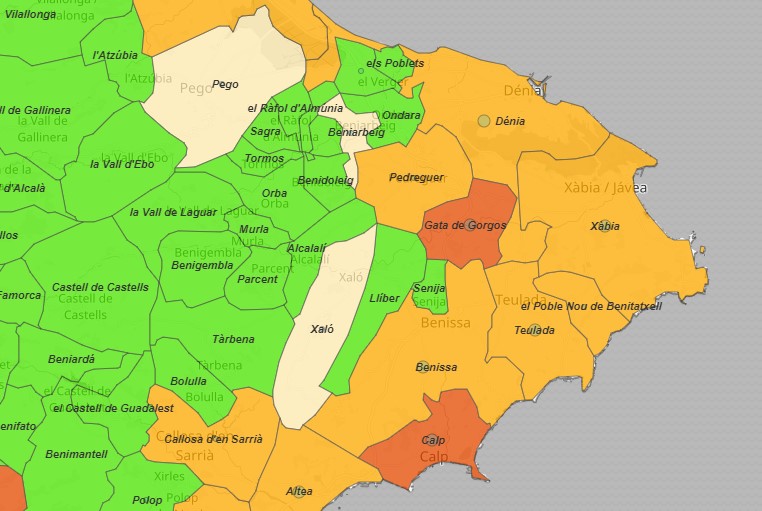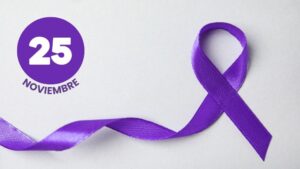VIRUS UPDATE: 22 new positives detected in Xàbia as town moves to Medium Risk level
The IA rate for the Marina Alta has climbed to 78.53 as 75 new positive cases are detected since the last update.

Friday 2nd July 2021 – Compiled by MIKE SMITH
The total number of positive coronavirus cases detected by PCR test in Xàbia has climbed to 1,535, according to the latest update from the regional health ministry. The number of cases detected in the past 14 days stands at 28 cases, which means that the municipality’s 14-day IA rate, a measure of the speed at which the virus moves through the population, has soared to to 99.94 cases per 100,000 inhabitants and the town has risen into the ‘Medium Risk’ alert level. There have been no new deaths in Xàbia since late March and the number remains at 12.
In the Marina Alta region, there have been 75 new positive cases detected in the past 14 days whilst the total number of positive cases since the pandemic began has been confirmed as 10,307 since the last update, a rise of 83:
- 22 – Xàbia
- 17 – Calp
- 15- Dénia
- 9 – Gata de Gorgos
- 9 – Teulada
- 5 – Benissa
- 3 – Poble Nou de Benitatxell
- 1 – El Vergel
- 1 – Pedreguer
- 1 – Pego
The region’s 14-day IA rate has risen to 78.53 cases per 100,000 inhabitants – 379% higher than two weeks ago – and the region is in the ‘Medium Risk’ category. There have been no new deaths since the last update and the region’s toll remains 203.
Calp (192.22) and Gata de Gorgos (154.33) have risen into the ‘High Risk’ level whilst Xàbia (99.94), Teulada (97.54), Benissa (97.45), Poble Nou de Benitatxell (67.39), Dénia (53.70) and Pedreguer (50.75) are all at the ‘Medium Risk’ alert level with Pego (49.34), Beniarbeig (46.32) and Xaló (34.87) now ‘Low Risk’ areas. The rest of the municipalities in the region are at the ‘New Normal’ level, with 22 of them, the majority inland rural communities, showing no infection spread over the last 14 days.
Spain
Spain’s 14-day IA rate is 134.31 cases per 100,000 inhabitants and the country remains in the ‘Medium Risk’ category. The rate has been rising for a week and is now 39% higher than it was two weeks ago. The numbers are clearly showing that the infection spread is being accelerated by the younger population who have not yet been vaccinated; the 20-29 age group has a 14-day IA rate of 366.74, almost three times higher than the national average, and only 10.1% of that age group have been fully immunized.
Consequently, the Positivity Rate, the measure of how many coronavirus tests return positive, has risen to 5.41%, more than 26% higher than two weeks ago. A value of 5% or less indicates that transmission of the virus is more or less under control.
Yet, despite the surge in cases across Spain, the pressure on the hospital system has not risen (so far), with 1.94% of beds in general wards occupied by patients being treated for COVID-19, down over 19% on two weeks ago, whilst 6.38% of ICU beds are occupied by such patients, down more than 28% on two weeks ago. This has been attributed to the fact that the majority of the people being affected are younger and less vulnerable but there are concerns that primary healthcare centres are dealing with these new cases rather than focusing on the vaccination campaign.
Across Spain, 11 of the 19 autonomous communities and cities has seen positives cases rise over the past two weeks with Cantabria and the Comunidad Valenciana particularly suffering a surge in infection spread (263% and 206% higher, respectively, than two weeks ago) whilst Cataluña leads the way with an IA rate of 238.83 cases per 100,000 population.
In terms of 14-day IA rate, Cataluña, Cantabria and Andalucia are currently at High Risk alert level, 14 autonomous regions are at Medium Risk level, Castilla-La Mancha is at Low Risk, and only Ceuta is at the New Normal.
The Comunidad Valenciana, once a region which could boast the lowest infection spread not just in Spain but across Europe, has seen infection spread soar by more 200% over the past two weeks, mainly in the younger population, and the regional health secretary Ana Barceló has stressed that “we continue to be concerned about the speed with which contagion is spreading, especially among the younger population,” stressing “the importance of continuing to take the utmost precautions and act with the utmost responsibility. Only with the effort of all citizens, as we have done so far, will we be able to control the pandemic“.
The newspaper El País has reported that it is the more contagious delta variant that is behind the surge in infection with Alex Arenas, a doctor in physics and data expert at the Rovira i Virgili University in Catalonia, explaining that “we’re seeing here what the United Kingdom suffered a few weeks ago“. Alberto Infante, a professor at Madrid’s Carlos III Health Institute, said that he believed that there is a race between the vaccines and the virus, and that “the virus is in the lead once more,” adding that “we have been warning that the deescalation has happened four or six weeks too early. If we had waited, there would be a lot more people immunized and we would have reached the summer with the figures falling, not rising, as we are now.“
Vaccination (01.07.21)
Spain has administered 42,027,584 doses of vaccine, which is 92.6% of those which it has already received. A total of 17,990,526 people have completed the recommended course, which is 42.7% of the total of the population which is to be vaccinated (40,129,822).
According to the latest data provided by the health authorities, 86.4% of people aged 40 and over in Spain have received at least one dose, with 54.2% having completed the recommended course.
The Comunidad Valenciana has administered 4,209,695 doses of vaccine, which is 89.6% of the total which it has received. A total of 1,817,598 people have completed the recommended course, which 40.5% of the population which is to be vaccinated (4,289,305).
According to the latest data provided by the health authorities, 82.8% of people aged 40 and over in the Comunidad Valenciana have received at least one dose, with 53.2% having completed the recommended course.
LINKS
- Actualización nº 409. Enfermedad por el coronavirus (COVID-19). 01.07.2021
- GIV COVID-19 Gestión integral de la vacunación COVID-19
- COVID-19 C. Valenciana: Monitoratge de la situació



